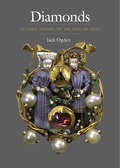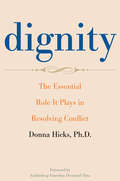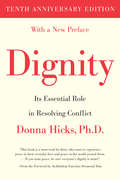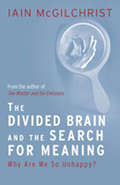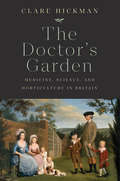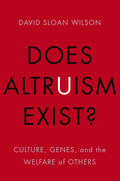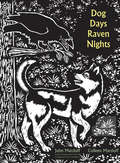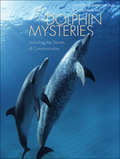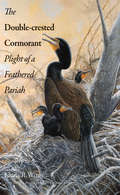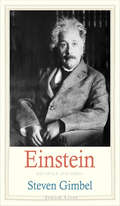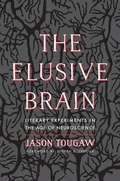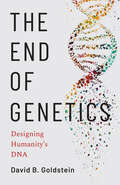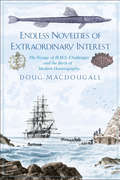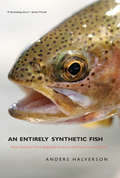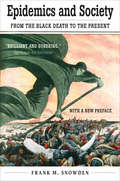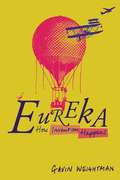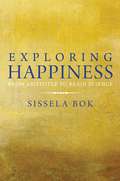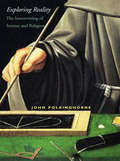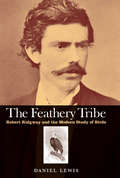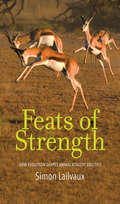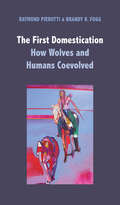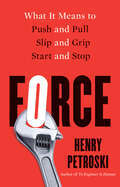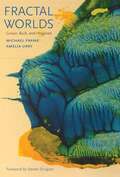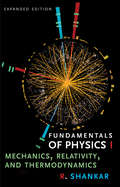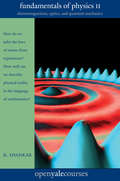- Table View
- List View
Diamonds: An Early History of the King of Gems
by Jack OgdenA lavishly illustrated, in-depth early history covering two thousand years of diamond jewelry and commerce, from the Indian mines to European merchants, courts, and workshops This richly illustrated history of diamonds illuminates myriad facets of the “king of gems,” including a cast of larger-than-life characters such as Alexander the Great, the Mughal emperor Jahangir, and East India Company adventurers. It’s an in-depth study tracing the story of diamonds from their early mining and trade more than two thousand years ago to the 1700s, when Brazil displaced India as the world’s primary diamond supplier. Jack Ogden, a historian and gemologist specializing in ancient gems and jewelry, describes the early history of diamond jewelry, the development of diamond cutting, and how diamonds were assessed and valued. The book includes more than one hundred captivating images, from close-up full-color photographs of historic diamond-set jewelry (some previously unpublished), to photomicrographs of individual gems and illustrations of medieval manuscripts, as well as diagrams depicting historical methods of cutting and polishing diamonds.
Dignity
by Donna HicksThe desire for dignity is universal and powerful. It is a motivating force behind all human interaction--in families, in communities, in the business world, and in relationships at the international level. When dignity is violated, the response is likely to involve aggression, even violence, hatred, and vengeance. On the other hand, when people treat one another with dignity, they become more connected and are able to create more meaningful relationships. Surprisingly, most people have little understanding of dignity, observes Donna Hicks in this important book. She examines the reasons for this gap and offers a new set of strategies for becoming aware of dignity's vital role in our lives and learning to put dignity into practice in everyday life. Drawing on her extensive experience in international conflict resolution and on insights from evolutionary biology, psychology, and neuroscience, the author explains what the elements of dignity are, how to recognize dignity violations, how to respond when we are not treated with dignity, how dignity can restore a broken relationship, why leaders must understand the concept of dignity, and more. Hicks shows that by choosing dignity as a way of life, we open the way to greater peace within ourselves and to a safer and more humane world for all.
Dignity: Its Essential Role in Resolving Conflict
by Donna HicksDrawing on her extensive experience in international conflict resolution and on insights from evolutionary biology, psychology, and neuroscience, Donna Hicks explains what the elements of dignity are, how to recognize dignity violations, how to respond when we are not treated with dignity, how dignity can restore a broken relationship, why leaders must understand the concept of dignity, and more. By choosing dignity as a way of life, Hicks shows, we open the way to greater peace within ourselves and to a safer and more humane world for all. For the Tenth Anniversary Edition of Dignity, Hicks has written a new preface that reflects on her experience helping communities and individuals understand the power of dignity and how it can lead to a more peaceful world. &“Anyone who understands the importance of personal feelings and their fuel for conflict should consider Dignity as a powerful advisory and motivational guide.&”—Midwest Book Review Winner of the 2012 Educator&’s Award, given by the Delta Kappa Gamma Society International.
The Divided Brain and the Search for Meaning
by Iain McgilchristIn this 10,000-word essay, written to complement Iain McGilchrist's acclaimed The Master and His Emissary, the author asks why - despite the vast increase in material well-being - people are less happy today than they were half a century ago, and suggests that the division between the two hemispheres of the brain has a critical effect on how we see and understand the world around us. In particular, McGilchrist suggests, the left hemisphere's obsession with reducing everything it sees to the level of minute, mechanistic detail is robbing modern society of the ability to understand and appreciate deeper human values. Accessible to readers who haven't yet read The Master and His Emissary as well as those who have, this is a fascinating, immensely thought-provoking essay that delves to the very heart of what it means to be human.
The Doctor's Garden: Medicine, Science, and Horticulture in Britain
by Clare HickmanA richly illustrated exploration of how late Georgian gardens associated with medical practitioners advanced science, education, and agricultural experimentation As Britain grew into an ever-expanding empire during the late eighteenth and early nineteenth centuries, new and exotic botanical specimens began to arrive within the nation&’s public and private spaces. Gardens became sites not just of leisure, sport, and aesthetic enjoyment, but also of scientific inquiry and knowledge dissemination. Medical practitioners used their botanical training to capitalize on the growing fashion for botanical collecting and agricultural experimentation in institutional, semipublic, and private gardens across Britain. This book highlights the role of these medical practitioners in the changing use of gardens in the late Georgian period, marked by a fluidity among the ideas of farm, laboratory, museum, and garden. Placing these activities within a wider framework of fashionable, scientific, and economic interests of the time, historian Clare Hickman argues that gardens shifted from predominately static places of enjoyment to key gathering places for improvement, knowledge sharing, and scientific exploration.
Does Altruism Exist?
by David Sloan WilsonDavid Sloan Wilson, one of the world’s leading evolutionists, addresses a question that has puzzled philosophers, psychologists, and evolutionary biologists for centuries: Does altruism exist naturally among the Earth’s creatures? The key to understanding the existence of altruism, Wilson argues, is by understanding the role it plays in the social organization of groups. Groups that function like organisms indubitably exist, and organisms evolved from groups. Evolutionists largely agree on how functionally organized groups evolve, ending decades of controversy, but the resolution casts altruism in a new light: altruism exists but shouldn’t necessarily occupy center stage in our understanding of social behavior. After laying a general theoretical foundation, Wilson surveys altruism and group-level functional organization in our own species—in religion, in economics, and in the rest of everyday life. He shows that altruism is not categorically good and can have pathological consequences. Finally, he shows how a social theory that goes beyond altruism by focusing on group function can help to improve the human condition in a practical sense. Does Altruism Exist? puts old controversies to rest and will become the center of debate for decades to come.
Dog Days, Raven Nights
by John M. Marzluff Colleen MarzluffTwenty years ago, fresh out of graduate school and recently married, John and Colleen Marzluff left Arizona for a small cabin in the mountains of western Maine. Their mission: to conduct the first-ever extensive study of the winter ecology of the Common Raven under the tutelage of biologist Bernd Heinrich. Drawing on field notes and personal diaries, they vividly and eloquently chronicle their three-year endeavor to research a mysterious and often misunderstood bird--assembling a gigantic aviary, climbing sentry trees, building bird blinds in the forest, capturing and sustaining 300 ravens as study subjects, and enduring harsh Maine winters in pursuit of their goal. They also shared the unique challenges and joys of raising, training, and racing the sled dogs that assisted them in their work. Accompanied by Evon Zerbetz's lovely linocut illustrations, Dog Days, Raven Nightsis a fascinating, behind-the-scenes look at the adventures of field science and an insightful exploration of the nature of relationships, both animal and human.
Dolphin Mysteries
by Kathleen M. Dudzinski Toni FrohoffDolphins have fascinated humans for millennia, giving rise to an abundance of stories and myths about them, yet the actual details of their lives in the sea have remained elusive. In this enthralling book, Kathleen M. Dudzinski and Toni Frohoff take us into the dolphins' aquatic world to witness firsthand how they live their lives, communicate, and interact with one another and with other species, including people. Kathleen M. Dudzinski and Toni Frohoff are scientists who have collectively dedicated more than 40 years to studying dolphins beneath the ocean's surface, frequently through a close-up underwater lens. Drawing on their own experiences and on up-to-the-minute research, the authors show that dolphins are decidedly not just members of a group but distinct individuals, able to communicate with one another and with humans. Dudzinski and Frohoff introduce a new way of looking at, and listening to, the vocabulary of dolphins in the sea, and they even provide an introductory "dolphin dictionary," listing complex social signals that dolphins use to share information among themselves and with people. Unveiling an intimate and scientifically accurate portrait of dolphins, this book will appeal to everyone who has wanted a closer glimpse into the hearts and minds of these amazing creatures.
The Double-crested Cormorant
by Linda R. WiresThe double-crested cormorant, found only in North America, is an iridescent black waterbird superbly adapted to catch fish. It belongs to a family of birds vilified since biblical times and persecuted around the world. Thus it was perhaps to be expected that the first European settlers in North America quickly deemed the double-crested cormorant a competitor for fishing stock and undertook a relentless drive to destroy the birds. This enormously important book explores the roots of human-cormorant conflicts, dispels myths about the birds, and offers the first comprehensive assessment of the policies that have been developed to manage the double-crested cormorant in the twenty-first century. Conservation biologist Linda Wires provides a unique synthesis of the cultural, historical, scientific, and political elements of the cormorant's story. She discusses the amazing late-twentieth-century population recovery, aided by protection policies and environment conservation, but also the subsequent U.S. federal policies under which hundreds of thousands of the birds have been killed. In a critique of the science, management, and ethics underlying the double-crested cormorant's treatment today, Wires exposes "management" as a euphemism for persecution and shows that the current strategies of aggressive predator control are outdated and unsupported by science.
Einstein
by Steven GimbelIs relativity Jewish? The Nazis denigrated Albert Einstein's revolutionary theory by calling it "Jewish science," a charge typical of the ideological excesses of Hitler and his followers. Philosopher of science Steven Gimbel explores the many meanings of this provocative phrase and considers whether there is any sense in which Einstein's theory of relativity is Jewish. Arguing that we must take seriously the possibility that the Nazis were in some sense correct, Gimbel examines Einstein and his work to explore how beliefs, background, and environment may-or may not-influence the work of the scientist. You cannot understand Einstein's science, Gimbel declares, without knowing the history, religion, and philosophy that influenced it. No one, especially Einstein himself, denies Einstein's Jewish heritage, but many are uncomfortable saying that he was a Jew while he was at his desk working. To understand what "Jewish" means for Einstein's work, Gimbel first explores the many definitions of "Jewish" and asks whether there are elements of Talmudic thinking apparent in Einstein's theory of relativity. He applies this line of inquiry to other scientists, including Isaac Newton, René Descartes, Sigmund Freud, and Émile Durkheim, to consider whether and how their specific religious beliefs or backgrounds manifested in their scientific endeavors. Einstein's Jewish Science intertwines science, history, philosophy, theology, and politics in fresh and fascinating ways to solve the multifaceted riddle of what religion means-and what it means to science. There are some senses, Gimbel claims, in which Jews can find a special connection to E = mc2, and this claim leads to the engaging, spirited debate at the heart of this book.
Elusive Brain: Literary Experiments in the Age of Neuroscience
by Jason Tougaw Joseph E. LeDouxFeaturing a foreword by renowned neuroscientist Joseph E. LeDoux, The Elusive Brain is an illuminating, comprehensive survey of contemporary literature’s engagement with neuroscience. This fascinating book explores how literature interacts with neuroscience to provide a better understanding of the brain’s relationship to the self. Jason Tougaw surveys the work of contemporary writers—including Oliver Sacks, Temple Grandin, Richard Powers, Siri Hustvedt, and Tito Rajarshi Mukhopadhyay—analyzing the way they experiment with literary forms to frame new views of the immaterial experiences that compose a self. He argues that their work offers a necessary counterbalance to a wider cultural neuromania that seeks out purely neural explanations for human behaviors as varied as reading, economics, empathy, and racism. Building on recent scholarship, Tougaw’s evenhanded account will be an original contribution to the growing field of neuroscience and literature.
The End of Genetics: Designing Humanity's DNA
by David B. GoldsteinAn urgent plea for a broader understanding and awareness of the unconsidered dangers of new genetic technologies Since 2010 it has been possible to determine a person&’s genetic makeup in a matter of days at an accessible cost for many millions of people. Along with this technological breakthrough there has emerged a movement to use this information to help prospective parents &“eliminate preventable genetic disease.&” As the prospect of systematically excluding the appearance of unwanted mutations in our children comes within reach, David B. Goldstein examines the possible consequences from these types of choices. Engaging and accessible, this clarion call for responsible and informed stewardship of the human genome provides an overview of what we do and do not know about human genetics and looks at some of the complex, yet largely unexplored, issues we must be most careful about as we move into an era of increasing numbers of parents exercising direct control over the genomes of their children.
Endless Novelties of Extraordinary Interest: The Voyage of H.M.S. Challenger and the Birth of Modern Oceanography
by Doug MacdougallA gripping tale of exploration aboard H.M.S. Challenger, an expedition that laid the foundations for modern oceanography From late 1872 to 1876, H.M.S. Challenger explored the world’s oceans. Conducting deep sea soundings, dredging the ocean floor, recording temperatures, observing weather, and collecting biological samples, the expedition laid the foundations for modern oceanography. Following the ship’s naturalists and their discoveries, earth scientist Doug Macdougall engagingly tells a story of Victorian-era adventure and ties these early explorations to the growth of modern scientific fields. In this lively story of discovery, hardship, and humor, Macdougall examines the work of the expedition’s scientists, especially the naturalist Henry Moseley, who rigorously categorized the flora and fauna of the islands the ship visited, and the legacy of John Murray, considered the father of modern oceanography. Macdougall explores not just the expedition itself but also the iconic place that H.M.S. Challenger has achieved in the annals of ocean exploration and science.
An Entirely Synthetic Fish
by Anders HalversonAnders Halverson provides an exhaustively researched and grippingly rendered account of the rainbow trout and why it has become the most commonly stocked and controversial freshwater fish in the United States. Discovered in the remote waters of northern California, rainbow trout have been artificially propagated and distributed for more than 130 years by government officials eager to present Americans with an opportunity to get back to nature by going fishing. Proudly dubbed "an entirely synthetic fish" by fisheries managers, the rainbow trout has been introduced into every state and province in the United States and Canada and to every continent except Antarctica, often with devastating effects on the native fauna. Halverson examines the paradoxes and reveals a range of characters, from nineteenth-century boosters who believed rainbows could be the saviors of democracy to twenty-first-century biologists who now seek to eradicate them from waters around the globe. Ultimately, the story of the rainbow trout is the story of our relationship with the natural world--how it has changed and how it startlingly has not.
Epidemics and Society: From the Black Death to the Present (The Open Yale Courses Series)
by Frank M. SnowdenA wide-ranging study that illuminates the connection between epidemic diseases and societal change, from the Black Death to Ebola This sweeping exploration of the impact of epidemic diseases looks at how mass infectious outbreaks have shaped society, from the Black Death to today. In a clear and accessible style, Frank M. Snowden reveals the ways that diseases have not only influenced medical science and public health, but also transformed the arts, religion, intellectual history, and warfare. A multidisciplinary and comparative investigation of the medical and social history of the major epidemics, this volume touches on themes such as the evolution of medical therapy, plague literature, poverty, the environment, and mass hysteria. In addition to providing historical perspective on diseases such as smallpox, cholera, and tuberculosis, Snowden examines the fallout from recent epidemics such as HIV/AIDS, SARS, and Ebola and the question of the world’s preparedness for the next generation of diseases.
Eureka
by Gavin WeightmanTracing the long pre-history of five twentieth-century inventions which have transformed our lives, Gavin Weightman reveals a fantastic cast of scientists and inspired amateurs whose ingenuity has given us the airplane, television, bar code, personal computer, and mobile phone. Not one of these inventions can be attributed to a lone genius who experiences a moment of inspiration. Nearly all innovations exist in the imagination before they are finally made to work by the hard graft of inventors who draw on the discoveries of others. While the discoveries of scientists have provided vital knowledge which has made innovation possible, it is a revelation of Weightman's study that it is more often than not the amateur who enjoys the "eureka moment" when an invention works for the first time. Filled with fascinating stories of struggle, rivalry, and the ingenuity of both famous inventors and hundreds of forgotten people, Weightman's captivating work is a triumph of storytelling that offers a fresh take on the making of our modern world. "
Exploring Happiness: From Aristotle to Brain Science
by Sissela BokIn this smart and timely book, the distinguished moral philosopher Sissela Bok ponders the nature of happiness and its place in philosophical thinking and writing throughout the ages. With nuance and elegance, Bok explores notions of happiness--from Greek philosophers to Desmond Tutu, Charles Darwin, Iris Murdoch, and the Dalai Lama--as well as the latest theories advanced by psychologists, economists, geneticists, and neuroscientists. Eschewing abstract theorizing, Bok weaves in a wealth of firsthand observations about happiness from ordinary people as well as renowned figures. This may well be the most complete picture of happiness yet. This book is also a clarion call to think clearly and sensitively about happiness. Bringing together very different disciplines provides Bok with a unique opportunity to consider the role of happiness in wider questions of how we should lead our lives and treat one another--concerns that don't often figure in today's happiness equation. How should we pursue, weigh, value, or limit our own happiness, or that of others, now and in the future? Compelling and perceptive,Exploring Happinessshines a welcome new light on the heart of the human condition.
Exploring Reality: The Intertwining of Science and Religion
by John PolkinghorneReality is multi-layered, asserts the Reverend John Polkinghorne, and in this insightful book he explores various dimensions of the human encounter with reality. Through a well-reasoned and logical process, Polkinghorne argues that reality consists not only of the scientific processes of the natural world but also the personal dimension of human nature and its significance. He offers an integrated view of reality, encompassing a range of insights deriving from physics' account of causal structure, evolutionary understanding of human nature, the unique significance of Jesus of Nazareth, and the human encounter with God.
The Feathery Tribe
by Daniel LewisAmateurs and professionals studying birds at the end of the nineteenth century were a contentious, passionate group with goals that intersected, collided and occasionally merged in their writings and organizations. Driven by a desire to advance science, as well as by ego, pride, honor, insecurity, religion and other clashing sensibilities, they struggled to absorb the implications of evolution after Darwin. In the process, they dramatically reshaped the study of birds. Daniel Lewis here explores the professionalization of ornithology through one of its key figures: Robert Ridgway, the Smithsonian Institution’s first curator of birds and one of North America’s most important natural scientists. Exploring a world in which the uses of language, classification and accountability between amateurs and professionals played essential roles, Lewis offers a vivid introduction to Ridgway and shows how his work fundamentally influenced the direction of American and international ornithology. He explores the inner workings of the Smithsonian and the role of collectors working in the field and reveals previously unknown details of the ornithological journalThe Aukand the untold story of the color dictionaries for which Ridgway is known.
Feats of Strength: How Evolution Shapes Animal Athletic Abilities
by Simon LailvauxA fascinating exploration of the extreme world of animal athletics, how these stunning abilities have evolved, and their insights into human performance and evolution How is it that fish can climb waterfalls, snakes glide, and cheetahs run so fast? Natural and sexual selection has driven the evolution of diverse and amazing athletic abilities throughout the animal kingdom. Integrative biologist Simon Lailvaux draws on decades of performance research to highlight the ecological and evolutionary importance of these abilities, which include running, jumping, flying, biting, climbing, and swimming, and explains the many reasons they exist. He describes the methods and tools scientists use to measure animal performance—remote sensing technologies that can capture a cheetah’s running speed, or force meters that gauge the strength of a lizard’s bite or crab’s grip—as well as the diverse mechanisms underlying and enabling spectacular animal athletic feats. Using examples from the smallest insects to birds, whales, and even dinosaurs, Lailvaux provides a unique glimpse into a vibrant, eclectic field of research and points to new directions for understanding performance evolution in both animals and humans.
The First Domestication: How Wolves and Humans Coevolved
by Raymond Pierotti Brandy R. FoggA riveting look at how dog and humans became best friends, and the first history of dog domestication to include insights from indigenous peoples In this fascinating book, Raymond Pierotti and Brandy Fogg change the narrative about how wolves became dogs and in turn, humanity’s best friend. Rather than describe how people mastered and tamed an aggressive, dangerous species, the authors describe coevolution and mutualism. Wolves, particularly ones shunned by their packs, most likely initiated the relationship with Paleolithic humans, forming bonds built on mutually recognized skills and emotional capacity. This interdisciplinary study draws on sources from evolutionary biology as well as tribal and indigenous histories to produce an intelligent, insightful, and often unexpected story of cooperative hunting, wolves protecting camps, and wolf-human companionship. This fascinating assessment is a must-read for anyone interested in human evolution, ecology, animal behavior, anthropology, and the history of canine domestication.
Force: What It Means to Push and Pull, Slip and Grip, Start and Stop
by Henry PetroskiAn eminent engineer and historian tackles one of the most elemental aspects of life: how we experience and utilize physical force &“Another gem from a master of technology writing.&”—Kirkus Reviews Force explores how humans interact with the material world in the course of their everyday activities. This book for the general reader also considers the significance of force in shaping societies and cultures. Celebrated author Henry Petroski delves into the ongoing physical interaction between people and things that enables them to stay put or causes them to move. He explores the range of daily human experience whereby we feel the sensations of push and pull, resistance and assistance. The book is also about metaphorical force, which manifests itself as pressure and relief, achievement and defeat. Petroski draws from a variety of disciplines to make the case that force—represented especially by our sense of touch—is a unifying principle that pervades our lives. In the wake of a prolonged global pandemic that increasingly cautioned us about contact with the physical world, Petroski offers a new perspective on the importance of the sensation and power of touch.
Fractal Worlds: Grown, Built, and Imagined
by Michael Frame Amelia UrryFractal geometry is a uniquely fascinating area of mathematics, exhibited in a range of shapes that exist in the natural world, from a simple broccoli floret to a majestic mountain range. In this essential primer, mathematician Michael Frame—a close collaborator with Benoit Mandelbrot, the founder of fractal geometry—and poet Amelia Urry explore the amazing world of fractals as they appear in nature, art, medicine, and technology. Frame and Urry offer new insights into such familiar topics as measuring fractal complexity by dimension and the life and work of Mandelbrot. In addition, they delve into less-known areas: fractals with memory, the Mandelbrot set in four dimensions, fractals in literature, and more. An inviting introduction to an enthralling subject, this comprehensive volume is ideal for learning and teaching.
Fundamentals of Physics I: Mechanics, Relativity, and Thermodynamics, Expanded Edition (The Open Yale Courses Series)
by R. ShankarA beloved introductory physics textbook, now including exercises and an answer key, explains the concepts essential for thorough scientific understanding In this concise book, R. Shankar, a well†‘known physicist and contagiously enthusiastic educator, explains the essential concepts of Newtonian mechanics, special relativity, waves, fluids, thermodynamics, and statistical mechanics. Now in an expanded edition—complete with problem sets and answers for course use or self†‘study—this work provides an ideal introduction for college†‘level students of physics, chemistry, and engineering; for AP Physics students; and for general readers interested in advances in the sciences. The book begins at the simplest level, develops the basics, and reinforces fundamentals, ensuring a solid foundation in the principles and methods of physics.
Fundamentals of Physics II: Electromagnetism, Optics, and Quantum Mechanics
by R. ShankarR. Shankar, a well-known physicist and contagiously enthusiastic educator, was among the first to offer a course through the innovative Open Yale Course program. His popular online video lectures on introductory physics have been viewed over a million times. In this second book based on his online Yale course, Shankar explains essential concepts, including electromagnetism, optics, and quantum mechanics. The book begins at the simplest level, develops the basics, and reinforces fundamentals, ensuring a solid foundation in the principles and methods of physics. It provides an ideal introduction for college-level students of physics, chemistry, and engineering; for motivated AP Physics students; and for general readers interested in advances in the sciences.
